Exchange 2016 Mail Flow Deep Dive
Let’s take a look at Mailflow with Exchange 2016. Mail flow changed from the previous versions and consists of transport pipelines.
The transport pipeline is a collection of services, connections, components, and queues that work together to route all messages to the categorizer in the Transport service on an Exchange 2016 Mailbox server inside the organization.
The transport Pipeline divided into four types:
-
Front End Transport service on Mailbox servers: Considered as a proxy service for all inbound and outbound external SMTP traffic for the Exchange 2016 organization which doesn’t inspect message content or queue any messages locally.
- Transport service on Mailbox servers: This service handles all SMTP mail flow for the organization, performs message categorization, and performs message content inspection but never communicates directly with mailbox databases.
-
Mailbox Transport service on Mailbox servers: This service consists of two separate services:
- Mailbox Transport Submission service: This service connects to the local mailbox database using an Exchange remote procedure call (RPC) to retrieve messages.
-
Mailbox Transport Delivery service: This service receives SMTP messages from the Transport service on the local Mailbox server or on other Mailbox servers and connects to the local mailbox database using RPC to deliver the messages.
- Mailbox Transport Submission service: This service connects to the local mailbox database using an Exchange remote procedure call (RPC) to retrieve messages.
- Transport service on Edge Transport servers: If you have an Edge Transport server installed in the perimeter network, this service handles all mails coming from the Internet or going to the Internet.
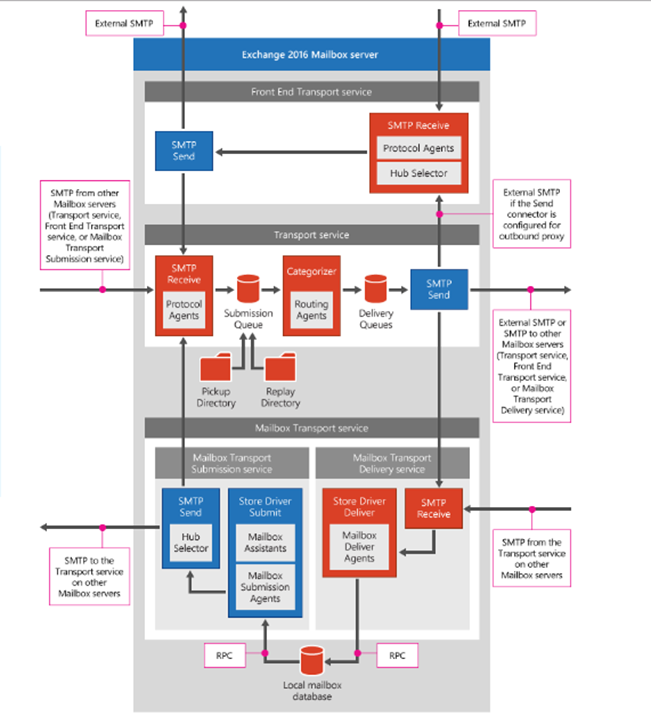
Diagrams Courtesy: TechNet
We can describe the mail flow as below four scenarios:
- Inbound messages from outside the Exchange organization
-
Outbound messages from inside the Exchange organization
Inbound messages from outside the Exchange organization
-
Inbound mail flow (no Edge Transport servers):
- A message from outside the organization enters the transport pipeline through the default Receive connector named “Default Frontend <Mailbox server name>” in the Front End Transport service.
- The message is sent to the Transport service on the local Mailbox server or on a different Mailbox server. The Transport service listens for messages on the default Receive connector named “Default <Mailbox server name>”.
- The message is sent from the Transport service to the Mailbox Transport Delivery service on the local Mailbox server or on a different Mailbox server.
- The Mailbox Transport Delivery service uses RPC to deliver the message to the local mailbox database.
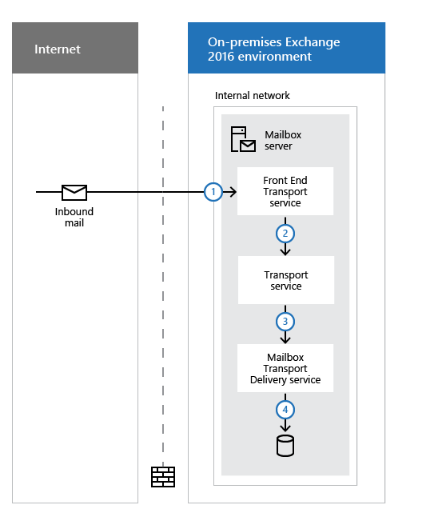
- A message from outside the organization enters the transport pipeline through the default Receive connector named “Default Frontend <Mailbox server name>” in the Front End Transport service.
-
Inbound mail flow with Edge Transport servers:
- A message from outside the Exchange organization enters the transport pipeline through the default Receive connector named “Default internal Receive connector <Edge Transport server name>” in the Transport service on the Edge Transport server.
- In the Transport service on the Edge Transport server, the default Send connector named “EdgeSync – Inbound to <Active Directory site name>” sends the message to a Mailbox server in the subscribed Active Directory site.
- In the Front End Transport service on the Mailbox server, the default Receive connector named “Default Frontend <Mailbox server name>” accepts the message.
- The message is sent from the Front End Transport service to the Transport service on the local Mailbox server or on a different Mailbox server. The Transport service listens for messages on the default Receive connector named “Default <Mailbox server name>”.
- The message is sent from the Transport service to the Mailbox Transport Delivery service on the local Mailbox server, or on a different Mailbox server.
- The Mailbox Transport Delivery service uses RPC to deliver the message to the local mailbox database.
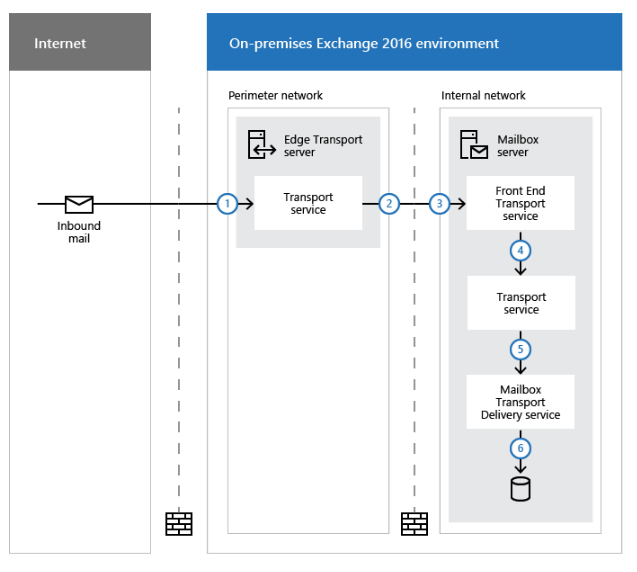
- A message from outside the Exchange organization enters the transport pipeline through the default Receive connector named “Default internal Receive connector <Edge Transport server name>” in the Transport service on the Edge Transport server.
Outbound messages from inside the Exchange organization
-
Outbound mail flow (no Edge Transport servers):
- The Mailbox Transport Submission service uses RPC to retrieve the outbound message from the local mailbox database.
- The Mailbox Transport Submission service uses SMTP to send the message to the Transport service on the local Mailbox server or on a different Mailbox server.
- In the Transport service, the default Receive connector named “Default <Mailbox server name>” accepts the message.
-
What happens next depends on the configuration of the Send connector:
- Default: The Transport service uses the Send connector you created to send the message to the Internet.
- Outbound proxy The Transport service uses the Send connector you created to send the message to the Front End Transport service on the local Mailbox server or on a remote Mailbox server. In the Front End Transport service, the default Receive connector named “Outbound Proxy Frontend <Mailbox server name>” accepts the message. The Front End Transport services sends the message to the Internet.
- Default: The Transport service uses the Send connector you created to send the message to the Internet.
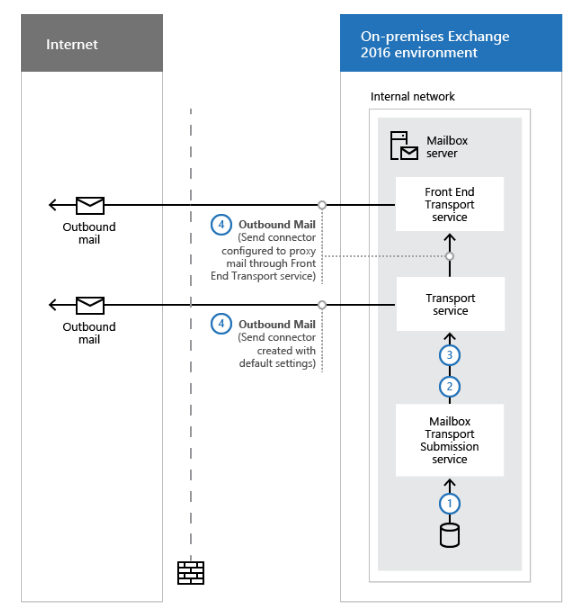
- The Mailbox Transport Submission service uses RPC to retrieve the outbound message from the local mailbox database.
-
Outbound mail flow with Edge Transport servers:
- The Mailbox Transport Submission service uses RPC to retrieve the outbound message from the local mailbox database.
- The Mailbox Transport Submission service uses SMTP to send the message to the Transport service on the local Mailbox server or on a different Mailbox server.
- In the Transport service on a Mailbox server in the subscribed Active Directory site, the default Receive connector named “Default <Mailbox server name>” accepts the message.
- The message is sent to the Edge Transport server using the implicit and invisible intra-organization Send connector that automatically sends mail between Exchange servers in the same organization.
- In the Transport service on the Edge Transport server, the default Receive connector named “Default internal Receive connector <Edge Transport server name>” accepts the message.
- In the Transport service on the Edge Transport server, the default Send connector named “EdgeSync – <Active Directory site name> to Internet” sends the message to the Internet.
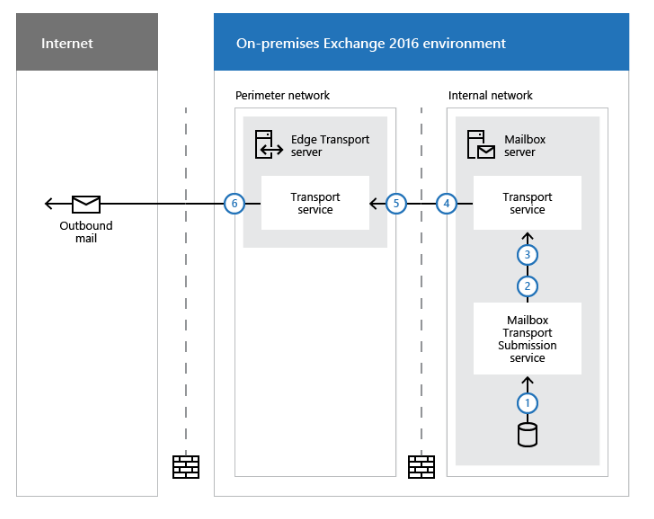
- The Mailbox Transport Submission service uses RPC to retrieve the outbound message from the local mailbox database.
Ratish Nair
Microsoft MVP | Office Servers and Services
Team @MSExchangeGuru


